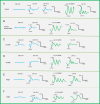Gene therapy shines light on congenital stationary night blindness for future cures
- PMID: 40181393
- PMCID: PMC11969737
- DOI: 10.1186/s12967-025-06392-8
Gene therapy shines light on congenital stationary night blindness for future cures
Abstract
Congenital Stationary Night Blindness (CSNB) is a non-progressive hereditary eye disease that primarily affects the retinal signal processing, resulting in significantly reduced vision under low-light conditions. CSNB encompasses various subtypes, each with distinct genetic patterns and pathogenic genes. Over the past few decades, gene therapy for retinal genetic disorders has made substantial progress; however, effective clinical therapies for CSNB are yet to be discovered. With the continuous advancement of gene-therapy tools, there is potential for these methods to become effective treatments for CSNB. Nonetheless, challenges remain in the treatment of CSNB, including issues related to delivery vectors, therapeutic efficacy, and possible side effects. This article reviews the clinical diagnosis, pathogenesis, and associated mutated genes of CSNB, discusses existing animal models, and explores the application of gene therapy technologies in retinal genetic disorders, as well as the current state of research on gene therapy for CSNB.
Keywords: Animal models; Congenital stationary night blindness; Full-field electroretinography; Gene editing; Gene therapy; Inherited retinal disease; Retina.
© 2025. The Author(s).
Conflict of interest statement
Declarations. Ethics approval and consent to participate: Not applicable. Consent for publication: Not applicable. Competing interests: Part of our work was supported by the grant from Hangzhou Bipolar Biotechnology Co., Ltd. Qingyang Ye from Hangzhou Bipolar Biotechnology Co., Ltd. has a role in the preparation of the manuscript.
Figures










References
-
- Masland RH. The fundamental plan of the retina. Nat Neurosci. 2001;4:877–86. - PubMed
-
- Baden T, Euler T. Retinal physiology: Non-Bipolar-Cell excitatory drive in the inner retina. Curr Biol. 2016;26:R706–8. - PubMed
-
- Zeitz C. Molecular genetics and protein function involved in nocturnal vision. Expert Rev Ophthalmo. 2007;2:467–85.
-
- Russell S, Bennett J, Wellman JA, Chung DC, Yu ZF, Tillman A, Wittes J, Pappas J, Elci O, McCague S, et al. Efficacy and safety of voretigene neparvovec (AAV2-hRPE65v2) in patients with RPE65-mediated inherited retinal dystrophy: a randomised, controlled, open-label, phase 3 trial. Lancet. 2017;390:849–60. - PMC - PubMed
Publication types
MeSH terms
Supplementary concepts
Grants and funding
LinkOut - more resources
Full Text Sources
Medical
Miscellaneous

